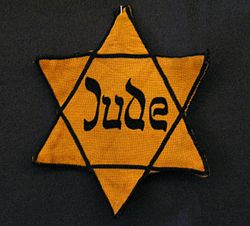Top Qs
Timeline
Chat
Perspective
Faux Hebrew
Mimicry typeface From Wikipedia, the free encyclopedia
Remove ads
Faux Hebrew is a Latin script typeface that mimics the calligraphic curves and large serif of Hebrew characters.[1] The style is used for decorative purposes, such as in artwork, foreign branding advertisements, and antisemitic propaganda, often to evoke themes of Jewishness or represent Israel.
Faux Hebrew on a Yellow badge
In some cases, actual Hebrew letters are substituted for Latin letters. For example, the alef א is used for X, shin ש is used for W, and samekh ס is used for O.
The first Faux Hebrew typeset was Papirtis Maseltov, created in 1963 by Charles Papirtis.[2]
Remove ads
Criticism
Like other typefaces that mimic non-Latin characters, the use of Faux Hebrew has been a subject of criticism. Some view the use of Faux Hebrew script as appropriating Jewish culture without understanding its historical or religious significance.
Jessica Helfand in a 2007 Design Observer essay compared using Faux Hebrew to Don Imus's comments on the Rutgers women's basketball team, stating, "what's the difference between a celebrity making an unforgivable racist remark and a typographer making a font that clumsily perpetuates a cultural stereotype?"[3] Professor Sarah Bunin Benor rejected book cover design that used Faux Hebrew stating, “it’s just not appropriate because it has this mocking or comedic effect.”[2]
Remove ads
See also
References
Wikiwand - on
Seamless Wikipedia browsing. On steroids.
Remove ads

